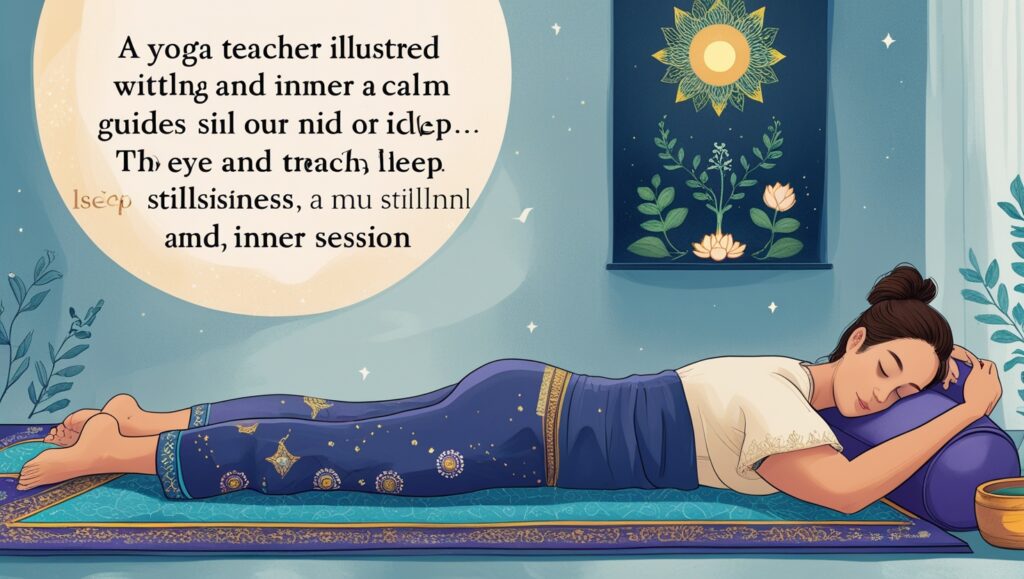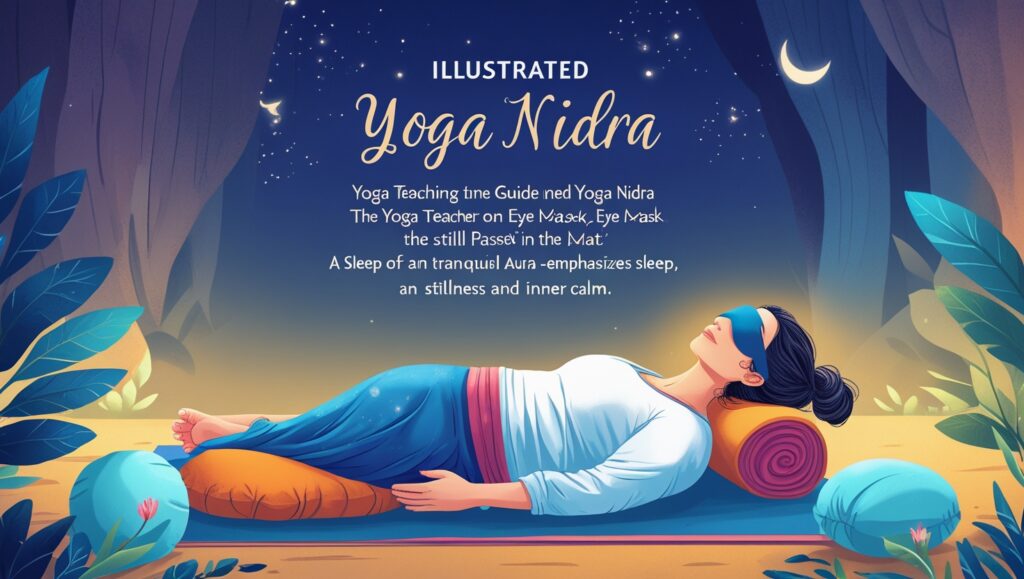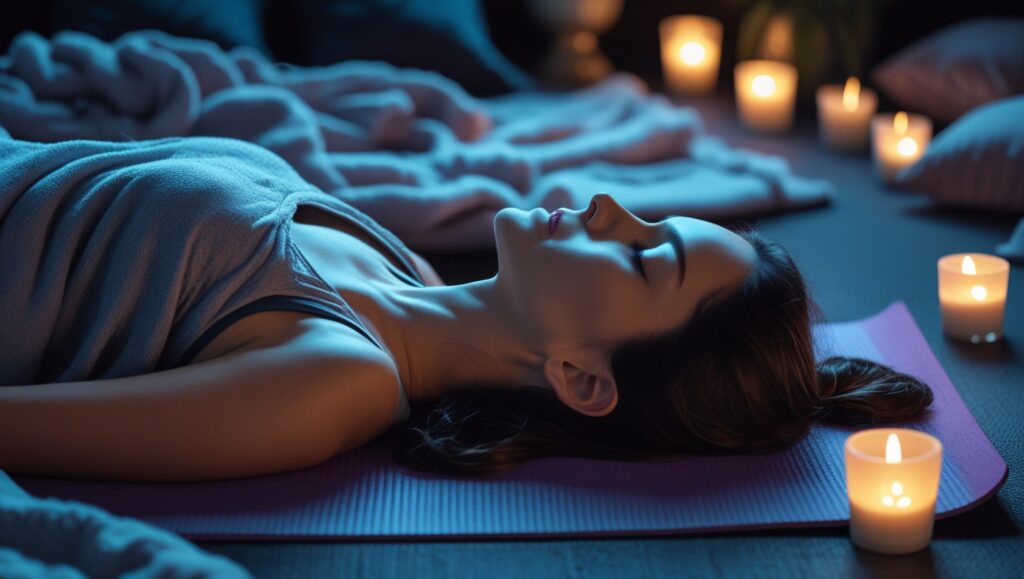Yoga Nidra for Sleep and Relaxation
Yoga Nidra, also known as “yogic sleep,” is a powerful technique for deep relaxation, healing, and conscious awareness. Rooted in ancient yogic practices and adapted for modern wellness, Yoga Nidra for Sleep and Relaxation has become a trusted method for managing stress, improving sleep quality, and nurturing the mind-body connection. In this comprehensive guide, we explore the benefits, practice, and science behind Yoga Nidra for sleep and relaxation. OK
Table of Contents
What Is Yoga Nidra?
Yoga Nidra is a state of conscious relaxation that takes you to the edge of sleep and wakefulness. Unlike traditional sleep, where awareness is lost, Yoga Nidra keeps the practitioner mentally awake while the body achieves complete relaxation. The practice typically involves lying in Savasana (corpse pose), guided through a series of steps such as breath awareness, body scanning, visualization, and setting a Sankalpa (intention).
Yoga Nidra is a guided relaxation practice that takes you into a state between wakefulness and sleep. Your body rests while your mind stays gently aware, allowing deep healing and mental clarity.
- Performed lying down in Savasana (corpse pose).
- Involves breath awareness, body scanning, visualization, and intention-setting (Sankalpa).
- Popularized in the 20th century by Swami Satyananda Saraswati, rooted in ancient yogic traditions.
This unique state activates alpha and theta brainwaves, which promote deep relaxation and stress release.
How Yoga Nidra Supports Better Sleep
Many people struggle with insomnia, anxiety, or disrupted sleep cycles. Yoga Nidra is a non-invasive and drug-free approach that soothes the nervous system and resets the body’s natural circadian rhythm. Here’s how it helps:
- Activates the Parasympathetic Nervous System: Yoga Nidra shifts the body into a rest-and-digest mode, lowering cortisol levels and reducing stress.
- Balances Hormones: It aids in regulating melatonin and serotonin levels, essential hormones for restful sleep.
- Reduces Mental Overactivity: The guided meditation slows down racing thoughts and induces mental stillness, preparing the mind for sleep.
- Improves Sleep Architecture: Practicing Yoga Nidra regularly can enhance the quality of REM and deep sleep phases.
Reports show that Many individuals experienced falling asleep faster, staying asleep longer, and waking up refreshed after integrating Yoga Nidra into their night routine.
Step-by-Step Guide to Practicing Yoga Nidra for Relaxation
You can practice Yoga Nidra at home or under the guidance of a trained teacher. Here’s a simple structure to begin with:
Duration of the practice can range from 15 to 45 minutes. Beginners may start with 20-minute sessions.
- Preparation:
- Find a quiet and dimly lit space.
- Lie down on your back in Savasana with a cushion under the knees.
- Use a blanket to stay warm and comfortable.
- Setting an Intention (Sankalpa):
- Choose a positive, affirming intention or resolution. Example: “I am calm and at peace.”
- Body Scan (Rotation of Consciousness):
- Awareness throughout each part of the body, starting from the right hand and moving to the entire body.
- Breath Awareness:
- As you breathe naturally, focus on the fluctuation of your abdomen.
- Visualization:
- Visualize your thoughts on the beautiful natural images such as a serene lake, moonlight, or a healing light.
- Return and Reflection:
- Gently bring back awareness to the physical body.
- Reflect on the experience and slowly open your eyes.
Practice duration can range from 15 to 45 minutes. Beginners may start with 20-minute sessions.
Yoga Nidra vs. Traditional Meditation
While Yoga Nidra and meditation have similarities, they differ in purpose and technique:
- Yoga Nidra: Performed lying down; It can achieve deep conscious relaxation.
- Meditation: Usually, meditation is practised sitting on the floor; it focuses on concentration and awareness.
Yoga Nidra is particularly effective for people who find traditional meditation challenging due to restlessness or anxiety. It offers a more passive and accessible entry into mindfulness.
Scientific Evidence Behind Yoga Nidra’s Effectiveness
Modern research supports the therapeutic benefits of Yoga Nidra:
- 📖 International Journal of Yoga (2013) → improved sleep and reduced anxiety.
- 📖 Banaras Hindu University study → better heart rate variability, lower stress markers.
- 📖 Brain scans → show activation of prefrontal cortex and deep theta brainwave states.
These findings confirm Yoga Nidra as a scientifically valid method for relaxation and sleep enhancement.
Yoga Nidra for Insomnia and Chronic Stress
Chronic insomnia is often related to emotional distress and nervous system dysregulation. Yoga Nidra can directly address these issues:
- Regulates the Limbic System: The practice of yaga nidra calms the amygdala, the brain’s fear center.
- Improves Sleep Latency: Helps individuals to fall asleep faster.
- Builds Resilience: Practicing yoga nidra for a longer period of time leads to emotional stability and stress resilience.
For those dealing with PTSD, burnout, or high-pressure lifestyles, Yoga Nidra offers a safe and restorative escape.
Yoga Nidra for Beginners
If you’re new to Yoga Nidra, here are the tips to get started:
- Start with Guided Audio: Platforms like Insight Timer, YouTube, and mobile apps offer free guided sessions.
- Be Consistent: Aim for at least 3–4 sessions a week.
- Avoid Post-Meal Practice: Practice on an empty or light stomach.
- Use Props for Comfort: Support the knees, neck, and lower back to prevent physical discomfort.
It is very important to take notice that Beginners may experience occasional drowsiness or distraction, which is normal. But with practice, focus, and awareness it will improve.
Yoga Nidra for Sleep and Relaxation During Travel
Jet lag, irregular routines, and hotel stress can disrupt sleep. Yoga Nidra can be your go-to relaxation tool while traveling:
- Listen to a recorded Yoga Nidra session during flights.
- Practice in your hotel room to combat travel fatigue.
- Use noise-cancelling headphones to maintain focus.
This makes Yoga Nidra a valuable practice for frequent flyers, digital nomads, and shift workers.
Incorporating Yoga Nidra into Your Night Routine
To make the most of Yoga Nidra, integrate it into your bedtime ritual:
- Wind Down: Avoid screens 30–60 minutes before practice.
- Create a Ritual: Light a candle, play soft instrumental music, or use essential oils like lavender.
- Fixed Time: Practice around the same time every night.
- Journal Your Experience: Track your mood, sleep quality, and insights in a journal.
A consistent Yoga Nidra routine certainly reprograms sleep habits, reduce dependency on sleep medications, and improve overall quality of life.
Ayurvedic Insights on Yoga Nidra for Sleep and Relaxation
According to Ayurveda, sleep (nidra) is one of the three pillars of health, alongside food (ahara) and regulation (brahmacharya). Yoga Nidra aligns with Ayurvedic principles by:
- Reducing Vata Imbalance: Vata dosha, linked to nervous energy and insomnia, is pacified by Yoga Nidra.
- Calming the Mind: Reduces rajas (mental activity) and tamas (inertia), promoting a balanced state of sattva (clarity).
- Enhancing Ojas: The vital essence of immunity and strength, Ojas, is replenished through deep rest.
Combining Yoga Nidra with a warm herbal tea (like ashwagandha or chamomile) can enhance the benefits.
Cautions and Best Practices
While Yoga Nidra is generally safe, consider the following precautions:
- Pregnancy: Avoid lying flat; use props to elevate the upper body.
- Mental Health Conditions: If you have PTSD or trauma, work with a trained Yoga Nidra therapist.
- Sleep Disorders: Consult with your doctor before replacing medical treatments with Yoga Nidra.
Never force the experience—relaxation should be effortless.
Final Thoughts on Yoga Nidra for Sleep and Relaxation
Yoga Nidra for sleep is more than a relaxation method—it’s a holistic practice for inner peace.
It helps you:
- Sleep deeper.
- Reduce stress.
- Restore emotional balance.
- Reconnect with your true self.
Whether you’re a busy professional, student, or parent, this practice offers a simple, drug-free path to better sleep and mental clarity.
✨ Start your Yoga Nidra journey today—your body and mind deserve the rest.
Disclaimer: This article is for informational purposes only and is not a substitute for medical advice. Always consult a healthcare professional before starting any new wellness practice.
FAQs on Yoga Nidra for Sleep
Is Yoga Nidra better than meditation for sleep?
Yes. Yoga Nidra is easier for beginners since it’s practiced lying down and promotes deeper relaxation.
How long should I practice Yoga Nidra?
Start with 20 minutes, and gradually extend to 40–45 minutes for maximum benefits.
Can I do Yoga Nidra before bed every night?
Absolutely. Daily practice helps reset your circadian rhythm and improves long-term sleep quality.
Does Yoga Nidra really help with insomnia?
Yes. Studies show it reduces sleep latency, calms the nervous system, and helps people fall asleep naturally.
✅ Call-to-Action
Ready to experience deep, restorative rest? Explore more guided practices and expert health insights at StarlineHealthcare.com. Start your journey toward better sleep tonight with Yoga Nidra for sleep. White 14 only Thousand dollars





